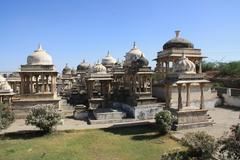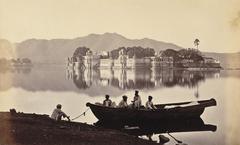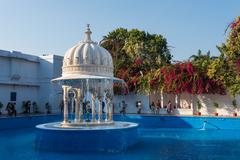Udaipur Solar Observatory: Visiting Hours, Tickets, and Complete Guide to Udaipur Historical Sites
Date: 04/07/2025
Introduction
The Udaipur Solar Observatory (USO), situated on a tranquil island within Fateh Sagar Lake, is celebrated as Asia’s leading solar research center. Established in 1976 under Dr. Arvind Bhatnagar, USO leverages Udaipur’s exceptional microclimate—over 250 days of sunlight and the stabilizing effects of the lake—for high-resolution solar observation. Its contributions to global solar physics, notably as part of the Global Oscillation Network Group (GONG), make it a cornerstone of both Indian and international scientific communities. Though public access inside is restricted, the observatory’s striking silhouette, seen from the shore, is a testament to India’s scientific ambitions and Udaipur’s unique blend of natural beauty and cultural richness.
This guide provides essential information on visiting hours, ticketing policies, accessibility, travel tips, and nearby attractions, along with historical and scientific context to help you plan a meaningful Udaipur visit. For official updates, refer to the Physical Research Laboratory website and Udaipur Tourism.
Table of Contents
- Historical Background and Development
- Visiting the Observatory: Hours, Tickets & Travel Tips
- Observatory Architecture and Scientific Facilities
- Accessibility and Visitor Amenities
- Visuals and Media
- Frequently Asked Questions (FAQ)
- Conclusion
- References
Historical Background and Development
Origins and Vision
Dr. Arvind Bhatnagar, inspired by the Big Bear Solar Observatory in California, established USO with the goal of creating a world-class solar research facility in India. The unique decision to build on Fateh Sagar Lake was driven by the scientific need to reduce atmospheric turbulence and ground heating, thereby ensuring better solar imaging and data accuracy (Wikipedia; Rajasthan Tour Planner).
Construction and Evolution
Initiated under the Vedshala Trust, construction concluded in 1976. The observatory quickly earned international recognition, participating in collaborative research and focusing on solar phenomena such as sunspots, flares, and prominences. In 1981, management transferred to the Physical Research Laboratory (PRL), integrating the observatory into India’s Department of Space (Udaipur Tourism).
Strategic Location and Architecture
USO’s island setting on Fateh Sagar Lake acts as a natural stabilizer, reducing image distortion from ground heat and air turbulence. Its domed white structures are both functional and iconic, serving as a visual landmark visible from the lake’s shore (Feel the Udaipur; My Udaipur City).
Integration into Global Solar Research
USO is integral to the Global Oscillation Network Group (GONG), providing essential solar data from a longitudinal gap between Australia and Spain. Its continuous observations contribute to worldwide understanding of solar activity, space weather, and their impacts on Earth (Udaipur Beats; Go Rajasthan Travel).
Technological Advancements
Notably, the Multi-Application Solar Telescope (MAST) became operational in 2015. With a 50 cm aperture, MAST enables high-resolution and 3D imaging of solar events. Other facilities include the GONG telescope, vector magnetographs, and advanced instrumentation labs (PRL USO; Rajasthan Tour and Travel).
Educational Contributions
USO is a hub for solar physics education in India. While public entry is limited, the observatory fosters educational outreach, Ph.D. programs, and science festivals—nurturing future generations of scientists (Go Rajasthan Travel).
Visiting the Observatory: Hours, Tickets & Travel Tips
Visiting Hours & Tickets
- General Public Access: The observatory is an active research facility with restricted entry. There are no regular public visiting hours, and tickets are not required to view the observatory from outside.
- Viewing: The best vantage points are along the Fateh Sagar Lake promenade, accessible year-round.
Guided Tours & Special Events
- Educational Tours: Occasionally, PRL or local authorities organize tours for students and researchers. Prior arrangement with PRL is mandatory.
- Special Events: During astronomical phenomena (e.g., solar eclipses), special observation sessions may be arranged.
Alternative Attractions & Viewpoints
- Fateh Sagar Lake: Enjoy lakeside walks and panoramic views of the observatory.
- City Palace: Explore Udaipur’s royal history and architecture.
- Saheliyon Ki Bari: Visit this historic garden for a taste of local heritage.
- Lake Pichola & Jag Mandir: Experience boat rides and striking views of Udaipur’s skyline.
Practical Travel Tips
- Best Season: October to March for pleasant weather.
- Photography: Bring a camera with zoom for distant photos.
- Transport: Taxis, auto-rickshaws, and local buses connect most city areas to the lake.
- Preparation: Contact PRL (PRL official website) well in advance for special visits.
Observatory Architecture and Scientific Facilities
- Domed Structures: Designed for minimal thermal expansion and optimal solar tracking, the domes are insulated and equipped with automated mechanisms.
- Instrument Housings: Specialized buildings accommodate sensitive telescopes like MAST, H-alpha telescopes, and magnetographs, each requiring precise environmental controls.
- Support Infrastructure: Includes emergency shelters, generators, and water storage, all discreetly integrated to protect the island’s ecosystem.
(Udaipur Online; directoryandnews.wordpress.com)
Accessibility and Visitor Amenities
- Access: The island location requires a boat ride for authorized visits; otherwise, the observatory is best viewed from the lake shore.
- Facilities: Basic amenities such as restrooms and a waiting area are available for educational groups. The site is not fully wheelchair accessible due to terrain and transport.
- Safety: Visitors must adhere to safety and conduct guidelines, especially during any authorized group visits.
Visuals and Media
- Images: Find high-resolution photos and virtual tours on the PRL website.
- Alt Tags: Use descriptive alt text such as “Udaipur Solar Observatory dome on Fateh Sagar Lake.”
- Maps: Embed a Google Map or provide a location map to aid trip planning.
Frequently Asked Questions (FAQ)
Can the public enter the Udaipur Solar Observatory?
No, public entry is generally restricted. The observatory can be viewed from Fateh Sagar Lake’s promenade.
Are tickets required for entry?
No tickets are required for external viewing. For educational tours, prior arrangement with PRL is essential.
What are the visiting hours?
There are no fixed public visiting hours; the site is visible from outside at all times.
Is the observatory accessible to people with disabilities?
The location and access methods pose challenges. Contact the observatory for specific needs.
Which nearby sites should I visit?
City Palace, Lake Pichola, Saheliyon Ki Bari, and Jag Mandir are highly recommended.
Conclusion
The Udaipur Solar Observatory stands at the confluence of scientific innovation, architectural ingenuity, and environmental stewardship. Its strategic island setting enhances both its research capabilities and its visual allure, making it a distinguished highlight in Udaipur’s landscape. Although public entry is restricted, the observatory’s presence alongside Udaipur’s historic sites offers a unique blend of science and culture. Plan your visit in advance, combine it with the city’s renowned attractions, and stay informed via official channels for the most rewarding experience.
References
- Physical Research Laboratory – Udaipur Solar Observatory
- Udaipur Tourism – Udaipur Solar Observatory
- Wikipedia – Udaipur Solar Observatory
- Rajasthan Tour Planner
- Feel The Udaipur
- Rajasthan Tour and Travel
- Go Rajasthan Travel
- Udaipur Beats
- My Udaipur City
- Udaipur Darpan
- Udaipur Times
- Directory and News
- Udaipur Online
Plan your Udaipur experience with the Audiala app, and follow us for exclusive updates and guides on Udaipur’s top scientific and cultural attractions.



